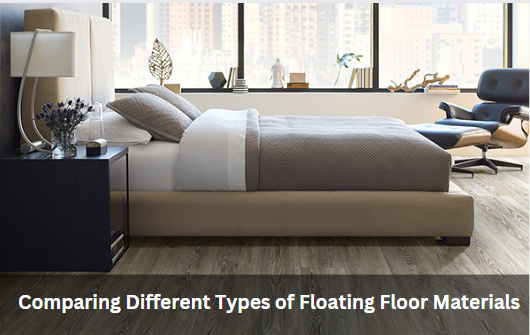Floating floors have become a popular choice for homeowners looking to enhance the comfort and aesthetics of their living spaces. In this blog post, we’ll explore what floating floors are, why they’re gaining popularity, and how they can transform your home.
Understanding Floating Floors
Floating floor refer to a type of flooring installation method where the floor material isn’t directly glued, nailed, or stapled to the subfloor. Instead, it “floats” over the subfloor, secured by its weight, interlocking mechanisms, or adhesive strips.
The Benefits of Floating Floors
Easy Installation
One of the primary benefits of floating floors is their straightforward installation process. They can be laid down quickly without the need for extensive subfloor preparation, making them ideal for both DIY enthusiasts and cost-conscious homeowners.
Material Versatility
Floating floors are available in a wide range of materials, including laminate, engineered wood, vinyl, and cork. This variety allows homeowners to choose a flooring material that matches their style, budget, and maintenance preferences.
Enhanced Comfort
The “floating” nature of these floors creates a cushioning effect, making them more comfortable to walk on compared to traditional nailed or glued-down floors. This added comfort is especially appreciated in areas where people stand for extended periods.
Moisture Resistance
Many floating floor materials are moisture-resistant or even waterproof, making them suitable for use in areas prone to humidity or occasional spills, such as bathrooms and kitchens.
Types of Floating Floors
Laminate Flooring
Laminate floating floors consist of a high-density fiberboard core with a decorative layer on top. They are known for their durability and affordability, making them a popular choice for budget-conscious homeowners.
Engineered Wood Flooring
Engineered wood floating floors feature real wood veneer bonded to layers of plywood or high-density fiberboard. They offer the authentic look of hardwood while being more stable and less susceptible to moisture.
Luxury Vinyl Planks (LVP)
Luxury vinyl plank floating floors mimic the appearance of hardwood or stone but are made of vinyl. They are known for their durability, easy maintenance, and wide range of styles.
Cork Flooring
Cork floating floors are made from the bark of cork oak trees. They are eco-friendly, comfortable to walk on, and have natural insulation properties.
Installation Considerations
Subfloor Preparation
While floating floors require less subfloor preparation than traditional methods, it’s essential to ensure that the subfloor is level, clean, and dry before installation.
Expansion Gaps
Floating floors need room to expand and contract with temperature and humidity changes. Installers typically leave small gaps around the edges of the room, which are covered with baseboards or molding.
Acclimatization
Some floating floor materials need to acclimate to the room’s conditions before installation. This ensures that they won’t expand or contract excessively after installation.
Maintenance and Care
Floating floors are relatively easy to maintain. Regular sweeping or vacuuming, along with occasional damp mopping, is usually sufficient. It’s essential to follow the manufacturer’s care instructions for the specific flooring material.
Popular Applications
Floating floors are versatile and can be used in various settings:
Residential Spaces
They are commonly used in living rooms, bedrooms, and dining areas, where comfort and aesthetics are paramount.
Kitchens and Bathrooms
Waterproof or moisture-resistant floating floors are an excellent choice for these areas due to their durability and ease of cleaning.
Commercial Settings
Floating floors are also used in commercial spaces, such as offices and retail stores, where quick installation and comfort underfoot are essential.
The Future of Floating Floors
As technology advances, we can expect even more innovative materials and installation methods in the world of floating floors. These developments will continue to enhance the comfort, durability, and style options available to homeowners and businesses.
Also Read – The Ultimate Guide to Installing Floating Floors in Any Room
Maintenance and Care: Keeping Your Floating Floors Pristine
Maintaining your floating floors is essential to ensure their longevity and overall appeal. Here are some tips to help you keep your floors in excellent condition:
Daily Cleaning Routine
- Regular Sweeping or Vacuuming: Dust and debris can accumulate on the surface of your floating floors, potentially causing scratches over time. Use a soft-bristle broom or a vacuum cleaner with a soft brush attachment to remove dirt daily.
- Damp Mopping: For more thorough cleaning, damp mop your floors using a well-wrung mop and a manufacturer-recommended cleaning solution. Avoid excessive moisture, as standing water can damage some types of floating floors.
Stain and Spill Management
- Immediate Action: Accidental spills happen, but it’s essential to address them promptly. Use a clean, damp cloth to wipe up spills as soon as they occur to prevent staining or warping.
- Avoid Harsh Chemicals: When cleaning, avoid harsh chemicals or abrasive cleaning agents that can damage the floor’s surface. Stick to products recommended by the flooring manufacturer.
Furniture Protectors
- Use Furniture Pads: Place felt or rubber protectors under the legs of heavy furniture to prevent indentations or scratches when moving or rearranging items.
Mats and Rugs
- Entry Mats: Placing entry mats at doorways helps trap dirt and moisture, preventing them from being tracked onto your floating floors.
- Area Rugs: In high-traffic areas or beneath furniture, use area rugs or mats to protect the floor’s surface. Ensure that these rugs have a non-slip backing to prevent shifting.
Sunlight Protection
- Sun Exposure: Prolonged exposure to direct sunlight can cause fading or discoloration of some flooring materials. Consider using curtains, blinds, or UV-blocking window films to protect your floors from the sun’s rays.
Regular Inspections
- Check for Damage: Periodically inspect your floating floors for any signs of damage, such as scratches, chips, or gaps between planks or tiles. Address any issues promptly to prevent further damage.
Manufacturer Guidelines
- Follow Manufacturer Recommendations: Always follow the care and maintenance guidelines provided by the flooring manufacturer. Different materials may have specific requirements, and adhering to these recommendations will help maintain your warranty.
By incorporating these maintenance and care practices into your routine, you can ensure that your floating floors remain in excellent condition and continue to enhance the beauty and comfort of your living spaces.
Additional Applications
In addition to the previously mentioned residential and commercial settings, floating floors are gaining popularity in other areas:
Educational Institutions
Many schools and universities are opting for floating floors in classrooms and common areas due to their durability, ease of maintenance, and noise-reduction qualities.
Healthcare Facilities
Floating floors are also being used in hospitals and clinics where hygiene, comfort, and sound reduction are essential. These floors can contribute to a quieter and more comfortable healing environment.
Hospitality Sector
Hotels and resorts are choosing floating floors for guest rooms and public spaces to create a welcoming and aesthetically pleasing ambiance.
Gyms and Fitness Centers
Floating floors are a popular choice in fitness facilities due to their cushioning effect, which reduces the impact on joints during workouts.
Cultural and Entertainment Spaces
Floating floors are found in theaters, auditoriums, and cultural centers, where their acoustic properties enhance the quality of performances and events.
Floating floors have evolved to meet the demands of various industries, making them a versatile choice for a wide range of applications.
In conclusion, floating floors offer not only a versatile and stylish flooring solution but also ease of maintenance. By following proper care practices and considering their applications in different settings, you can fully appreciate the comfort, durability, and style that floating floors bring to your space.
In Conclusion: Elevate Your Space with Floating Floors
Floating floors offer a winning combination of easy installation, versatility, comfort, and style. Whether you’re looking to renovate your home or create a welcoming commercial space, consider the many benefits that floating floors can bring to your project. Their ability to transform your space while accommodating your budget and style preferences makes them a popular choice for modern living. Upgrade your floors today and experience the comfort and convenience of floating floors.



